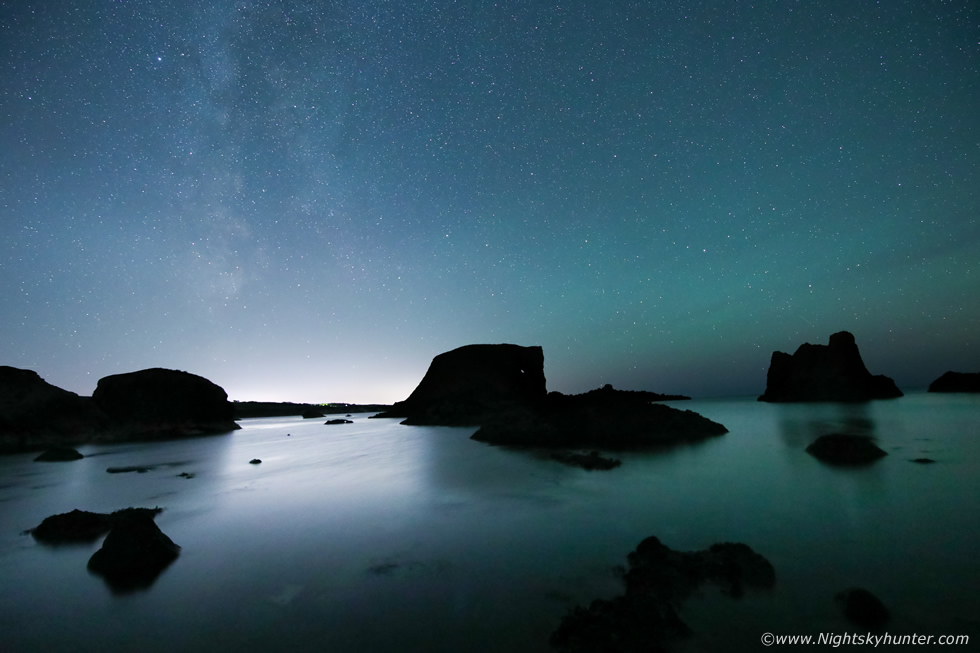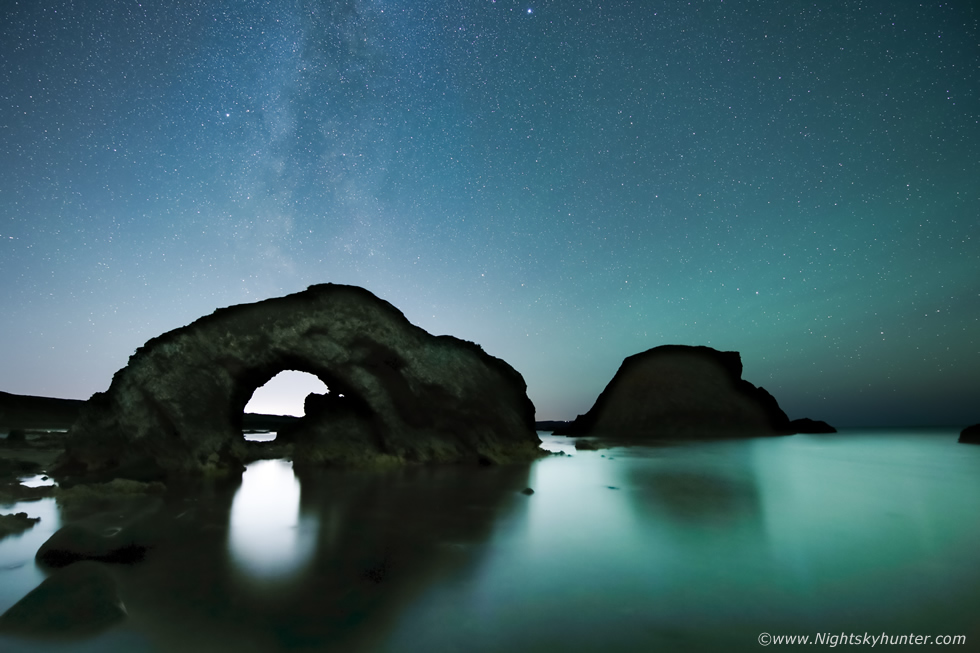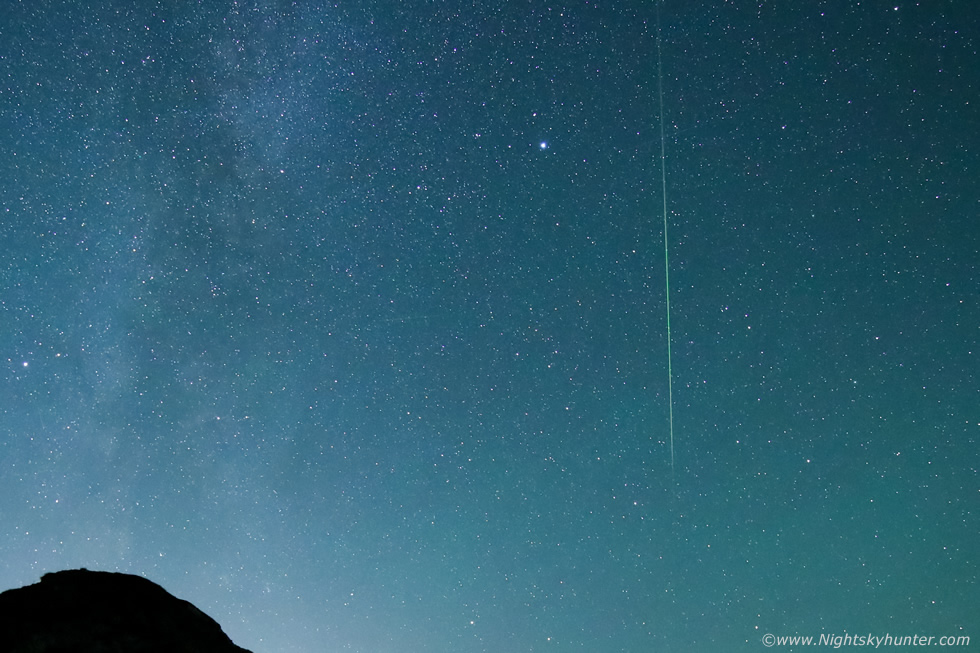
 |
It felt great to get another night shoot in so early in the new season, we had a run of clear nights this week however I deliberately held back as there were issues with mist then high level cloud which wasn't forecast so I targeted Wednesday August 31st as the forecast looked clear all night long and the transparency looked decent with the waxing crescent Moon setting early so it looked good for a dark clear night under the stars.
I made arrangements with Nigel McFarland and Colleen Webb, our plan was to meet at Ballintoy Harbour on the Co. Antrim coast with the intention of shooting the Milky Way with perhaps some location/foreground scouting in preparation for future shoots this season. We met at Ballintoy just as Astronomical twilight was in the process of transitioning to full darkness. We made our way to the W side between Ballintoy and White Park Bay to visit the famous 50 million year old sea stacks. When we arrived on the cobbled beach we set our gear down and took in the sky, the stars were amazing, the night was dead calm with just a hint of a breeze, even the ocean was calm and smooth, all of us were struck by just how tranquil it was, so much so that for some reason we talked among ourselves in whispers as if we didn't want to interrupt the serenity. This was Colleen's first time here at night and she was loving it just as much as we were.
 |
The Milky Way was stunning with the naked eye, especially my favourite region between Aquila, Scutum and Serpens Cauda where even without optical aid the dense star forming regions actually looked like a patch of cloud. This region was still well placed high above the horizon so I wanted to shoot it before it lowered into strong light pollution and became affected by atmospheric extinction. Unfortunately I had no foreground to work with so I just included the top of this cliff. This is a stack of eight 10 sec exposures at ISO6400 with a 50mm F/1.8 lens stopped down to F/2.2 on full frame (untracked) and merged using Sequator. I will admit I had to do quite a lot of editing to bring out the details and I was heavy handed with the contrast but this region of sky needs it to show the complex structures. I would loved to have had a person standing on that cliff looking up, that would have made for a great scene.
Nigel and Colleen were taking their own images too with the 50mm and wide angle, our intentions were to get the Milky Way over the sea stacks however this region of sky was still quite far around over land so it would be quite some time before it moved into a better alignment due to the Earth's rotation. As it happened we had something to occupy our minds while we waited, Colleen checked online and noticed that the Bz had dropped to -7, this wasn't expected at all, nothing was forecast on NOAA's site, we had a solar wind stream the night before but it had since passed through so this must have been some random dip.
Our view was blocked by the rocks so we found a tall stack and the three of us climbed to the top which offered us a tremendous view across the ocean. In the distance was a huge cruise ship lit up in spectacular fashion far out between Rathlin Island and Scotland, and there was also an aurora!, we could see it easily with our well developed dark adaption as an enhancement or glow in the sky 15 degrees in height, we took images and our camera's picked up an array of green and purple beams. We got our camera's re-composed and began shooting a time lapse, then the Bz went N and the aurora faded away to nothing. It was still a very nice unexpected treat to see it all the same, I got images however they are not worth posting.
 |
The aurora was gone yet the sky seemed to possess an unearthly glow, our cameras picked up the phenomena very clearly, this was what atmospheric scientists call 'airglow' or 'nightglow'. The process which creates airglow is quite involved so I would invite you to google and read how it forms so I can save space on this report. I've observed airglow quite a few times before, it usually has been subtle, the best example I ever witnessed was from Co. Donegal many years ago, however this formation was hands down the most vibrant I've ever observed. It covered a large portion of the N to NW and even parts of the NE sky sectors. In this exposure not only can you see the green airglow but also structure in the form of horizontal banding passing over the paws of The Great Bear. Airglow can look like a false aurora and some have certainly confused the glow for the northern lights, this is easy to forgive because many new aurora observers have never heard of the phenomena before.
 |
Later in the night we made our way down the steep slope of the stack upon which we stood, then carefully headed back towards our small beach and formations of stacks. The night was still tranquil beyond description, we noticed that the tide was well out which exposed many rock formations. Nigel and I each slipped into our own minds as we tried to suss out creative compositions, Nigel drifted off to work his own angles and I worked this area, just trusting our instincts and trying different compositions. This was facing W/NW over a dark outline of the stacks, it was then that I noticed just how vivid the airglow was, I could see its subtle green colour in the sky and the green reflecting upon the calm sea, it really was a special experience, this was a single exposure at a very high ISO.
 |
Nigel's voice came from the darkness somewhere, I couldn't see him as were were in 'lights out' mode, he said he could get quite close to the famous arch now that the tide was out. So I slowly and carefully made my way over in that direction, I stopped half way to shoot this scene with elephant rock and Milky Way. The galactic core was now in the S and getting better positioned with the stacks, however what shocked us was the light pollution coming from Bushmills and Portrush which literally blew out or exposures in that region. This was a real problem, we were literally shooting back inland towards LP, however despite our frustrations there was nothing we could do about it, in fact, we had to work with it and get what we could, I actually liked the glow on the water contrasting with the green from the air glow.
 |
I then made my way around to the sea arch, I stepped across the newly exposed rocks and got up close to the water's edge and set-up the tripod and eventually found this composition which I really liked. Sea arch, elephant rock, Milky Way and green airglow, I deliberately placed the arch in front of the light pollution, that way it blocked some of the intensity and the glow itself back-lit the arch which actually seemed to work in a strange way. The green airglow was at its most intense at this stage (02.00 BST) and the shadows and reflections complimented the scene thanks to the unusually calm sea. I was on my knees on the rocks checking the composition through the viewfinder when I sensed movement beside me. I switched on my head torch and shone it down and there where three large crabs beside my knee, their presence freaked me out for a second then I grew accustomed to them, it actually was a nice experience seeing the crabs in a rock pool glowing green.
This was taken with the full frame, 15-30mm F/2.8 lens at 15mm, ISO8000 for 13 sec's, this is eight exposures stacked using Sequator which done an amazing job. The stacking not only removed noise but improved the dynamic range of the image and brought out more definition in the Milky Way and airglow including the green colour. The sea is smooth looking because it was a long exposure and several stacked which enhanced this effect. I think this might actually be my favourite night image of the season so far.
 |
I then began shooting a time lapse so I left the camera alone on the rock taking constant 13 sec exposures. Nigel and I met on the beach and chatted for over an hour while watching the sky. Then we saw the best meteor of the night, mag +1 with an orange head and a 20 degree long orange tail which burned up not far from Vega, I back-tracked its path and noted it came from Taurus, so this was likely an early Southern Taurid, a long duration shower with weak numbers visible all through September into October, this stream originates from comet 2P/Encke and is famous for its bright meteors and fireballs, of which there will be more to come this Autumn. I checked through my images and there it was, although not a fireball it made a healthy looking trail in the image over the stacks, for me this was a nice end to a good shoot at the north coast.
 |
Deep crop of the southern Taurid with Vega, Milky Way and Altair to the left. I asked Nigel what time it was?, he replied ''3am'', we couldn't believe how fast time had flown so we made our way back and called it a night. I was back home for 04.30 BST. We made good use of a fine clear night, now I can't wait for more night shoots and aurora hunting this Autumn, we are long over due a major aurora event!, thanks for reading.
Martin McKenna